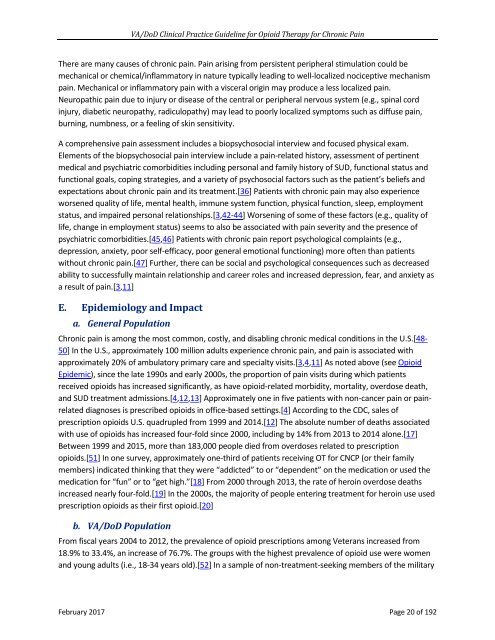VA/DoD CLINICAL PRACTICE GUIDELINE FOR OPIOID THERAPY FOR CHRONIC PAIN
2lfFhbO
2lfFhbO
You also want an ePaper? Increase the reach of your titles
YUMPU automatically turns print PDFs into web optimized ePapers that Google loves.
<strong>VA</strong>/<strong>DoD</strong> Clinical Practice Guideline for Opioid Therapy for Chronic Pain<br />
There are many causes of chronic pain. Pain arising from persistent peripheral stimulation could be<br />
mechanical or chemical/inflammatory in nature typically leading to well-localized nociceptive mechanism<br />
pain. Mechanical or inflammatory pain with a visceral origin may produce a less localized pain.<br />
Neuropathic pain due to injury or disease of the central or peripheral nervous system (e.g., spinal cord<br />
injury, diabetic neuropathy, radiculopathy) may lead to poorly localized symptoms such as diffuse pain,<br />
burning, numbness, or a feeling of skin sensitivity.<br />
A comprehensive pain assessment includes a biopsychosocial interview and focused physical exam.<br />
Elements of the biopsychosocial pain interview include a pain-related history, assessment of pertinent<br />
medical and psychiatric comorbidities including personal and family history of SUD, functional status and<br />
functional goals, coping strategies, and a variety of psychosocial factors such as the patient’s beliefs and<br />
expectations about chronic pain and its treatment.[36] Patients with chronic pain may also experience<br />
worsened quality of life, mental health, immune system function, physical function, sleep, employment<br />
status, and impaired personal relationships.[3,42-44] Worsening of some of these factors (e.g., quality of<br />
life, change in employment status) seems to also be associated with pain severity and the presence of<br />
psychiatric comorbidities.[45,46] Patients with chronic pain report psychological complaints (e.g.,<br />
depression, anxiety, poor self-efficacy, poor general emotional functioning) more often than patients<br />
without chronic pain.[47] Further, there can be social and psychological consequences such as decreased<br />
ability to successfully maintain relationship and career roles and increased depression, fear, and anxiety as<br />
a result of pain.[3,11]<br />
E. Epidemiology and Impact<br />
a. General Population<br />
Chronic pain is among the most common, costly, and disabling chronic medical conditions in the U.S.[48-<br />
50] In the U.S., approximately 100 million adults experience chronic pain, and pain is associated with<br />
approximately 20% of ambulatory primary care and specialty visits.[3,4,11] As noted above (see Opioid<br />
Epidemic), since the late 1990s and early 2000s, the proportion of pain visits during which patients<br />
received opioids has increased significantly, as have opioid-related morbidity, mortality, overdose death,<br />
and SUD treatment admissions.[4,12,13] Approximately one in five patients with non-cancer pain or painrelated<br />
diagnoses is prescribed opioids in office-based settings.[4] According to the CDC, sales of<br />
prescription opioids U.S. quadrupled from 1999 and 2014.[12] The absolute number of deaths associated<br />
with use of opioids has increased four-fold since 2000, including by 14% from 2013 to 2014 alone.[17]<br />
Between 1999 and 2015, more than 183,000 people died from overdoses related to prescription<br />
opioids.[51] In one survey, approximately one-third of patients receiving OT for CNCP (or their family<br />
members) indicated thinking that they were “addicted” to or “dependent” on the medication or used the<br />
medication for “fun” or to “get high.”[18] From 2000 through 2013, the rate of heroin overdose deaths<br />
increased nearly four-fold.[19] In the 2000s, the majority of people entering treatment for heroin use used<br />
prescription opioids as their first opioid.[20]<br />
b. <strong>VA</strong>/<strong>DoD</strong> Population<br />
From fiscal years 2004 to 2012, the prevalence of opioid prescriptions among Veterans increased from<br />
18.9% to 33.4%, an increase of 76.7%. The groups with the highest prevalence of opioid use were women<br />
and young adults (i.e., 18-34 years old).[52] In a sample of non-treatment-seeking members of the military<br />
February 2017 Page 20 of 192


